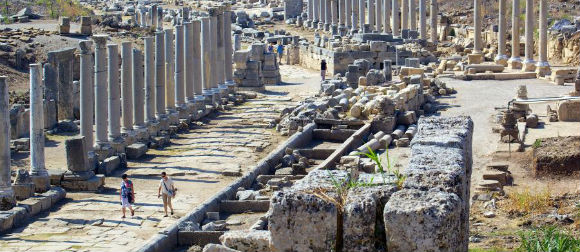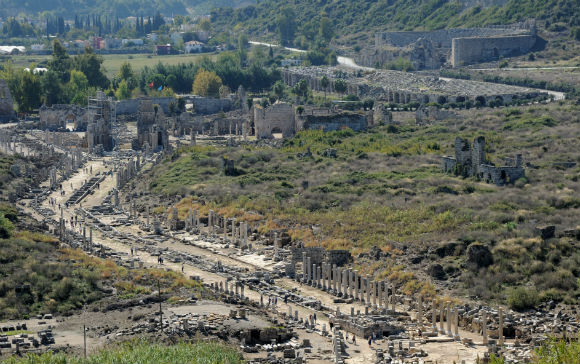The most impressive ruins of the Pamphylian coast are at Perge, at about 15 km east of Antalya. Perge was originally founded by the Hittites around 1500 BC. and was known as Parha. It was a successful trading centre near the Aksu (ancient Kestros or Cestrus) river when Alexander the Great arrived in 333 BC. He was welcomed in by the inhabitants and used Perge as base for his Anatolian campaigns. Alexander was followed by the Seleucids under whom the city prospered and Perge’s most celebrated inhabitant, the mathematician Apollonius from Perge lived and worked. Apollonius was a pupil of Archimedes and wrote a series of eight books on geometry. In 188 BC Perge became part of the Roman Empire during which the city flourished. Most of the surviving buildings date from this period.In 46 AD St. Paul started his journey in Perge (biblical Perga) and preached his first sermon here. Perge gradually declined during the Byzantine period, as the Aksu river silted, but remained inhabited until Selçuk times after which it became abandoned.
A visit to Perge starts by entering the archeological site through the Roman Gate, built during the reign of Septimius Severus (193-211 AD). Proceeding through the gate, to the right is the Agora or market place. This structure of 75 x 75 m dates back from the 2nd century AD. The center courtyard and shops were surrounded by a wide stoa, a covered walkway. The floor of the stoa and shops was made of colored mosaics. The agora was not only the centre of Perge’s trade, but was also a place for meetings as well as a forum for political, social, and philosophical discussions. The next building is the Hellenistic city gate that dates back to the 3rd century BC. This is certainly the most imposing building of the city and was cleverly designed to protect the city with its twin towers and its horseshoe-shaped courtyard at the back. It is thought that the towers had three floors and were crowned by a conical roof. In the year 121 AD, the horseshoe-shaped courtyard was rededesigned as a courtyard of honor. Behind the courtyard stood a triple arch. Around the arch there are about dozen inscriptions connected with Plancia Magna who lived in the 2nd century AD. She was the daughter of the governor, a priestess of Artemis Pergaia (Diana) and a benefactress to the city. Plancia Magna had the arch decorated with the statues of the emperors and their relatives.
After passing through the Hellenistic Gate and courtyard, one enters a broad, marble-paved double-colonnaded street measuring 300 meters in length that extends from the main gate to the acropolis. The street is 20 m wide and is divided in two by a 2 meter wide water channel running down the middle. At the end of the colonnaded street is the Nymphaeum, a triumphal fountain from where a stream flowed down into the water channel. The nymphaeum or nymphaion is an ornamental semicircular structure and dates from the reign of Emperor Hadrian (130-150 AD). A statue of a river god Kestros was located in the center of this huge fountain. Behind the nymphaeum is the acropolis with some remains of the Byzantine period. To the west of the nymphaeum are the remains of a palaestra dating from 50 AD and dedicated to the Emperor Cladius (41-54 AD).
Returning back to the entrance, there are the excavated Roman baths located southwest to the agora. Out of the site proper, is the horsehsoe-shaped stadium, the largest in Asia Minor, measuring 234 m by 34 m. The stadium had a seating capacity of 12,000 people supported by massive barrel-vaulted constructions. Just beyond the site entrance is also the theatre, which is of the Greco-Roman type and could seat 15,000 people. Unfortunately, it is for some time under reconstruction and unfortunately closed to visitors.
Perge,



Wonderfull historic site, don't forget to visit the Antalya museum to complete this experience.
Wear good shoes for this visit.
I was bewildered to saw it ,it is just amazing place to see, our touristic company adviced us to see perge because it's architecture,and it's hisotry,and we where very glad to visit perge,
We travelled to Perge from Side by car (took just under an hour) – the site cost 15 lira each to enter (currently around £5). We purchased a guide book for 1 lira and toured the site without a guide, which meant that we could go at our own pace and – when we timed it right – we saw…
The place is huge. You can see the stadium, the theatre, the main square (acropola), the water system etc. You can climb on the hill above the site and you can see it from there… amazing view.
The walls around the city are also relatively preserved so you can see and feel the size of the city.
If you are…
it was amazing to walk in places where Romans, Byzantines, and many others lived, worked…. Makes you appreciate your faith in a deeper way….
Very interesting with lots of information. The pillars remaining are fabulous as are the baths.
If you are into ancient ruins Perge is a must see day visit when your staying in or around Antalya. This was a city over 2000 years old with the outer gates into a courtyard so they could see who you where before letting you through the inner city gates still there.The layout of the baths they used and the…
Well worth the visit to see such incredible ruins. Perge is definitely a little off the beaten path but once we got there it was worth the trip.
A brill tour guide and such vast info on the baths and even the tracks wore into the ground from the horse cart wheels, the perfect alignment of the columns, everything. The carvings on the crumbling pieces of stone on the ground even with cherubs. great day go if you get the chance
Great historical site with great atmosphere. Archaeologically largely unexplored. Explored "only" roman bath and areas around main street. Perfect fountain cross down city. Its pity that upper city isnt available for tourist.